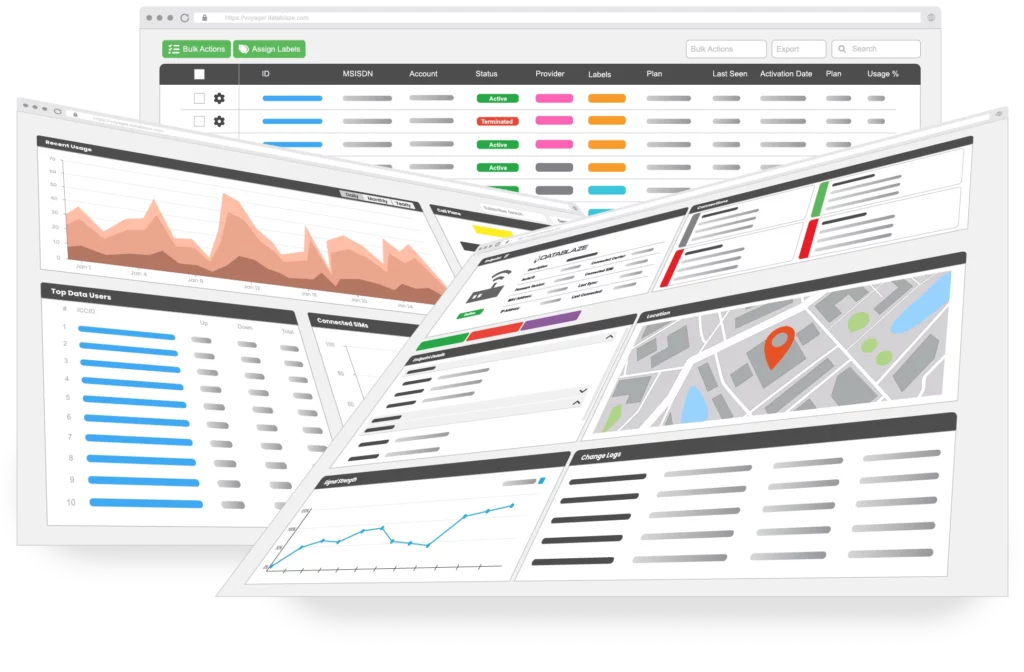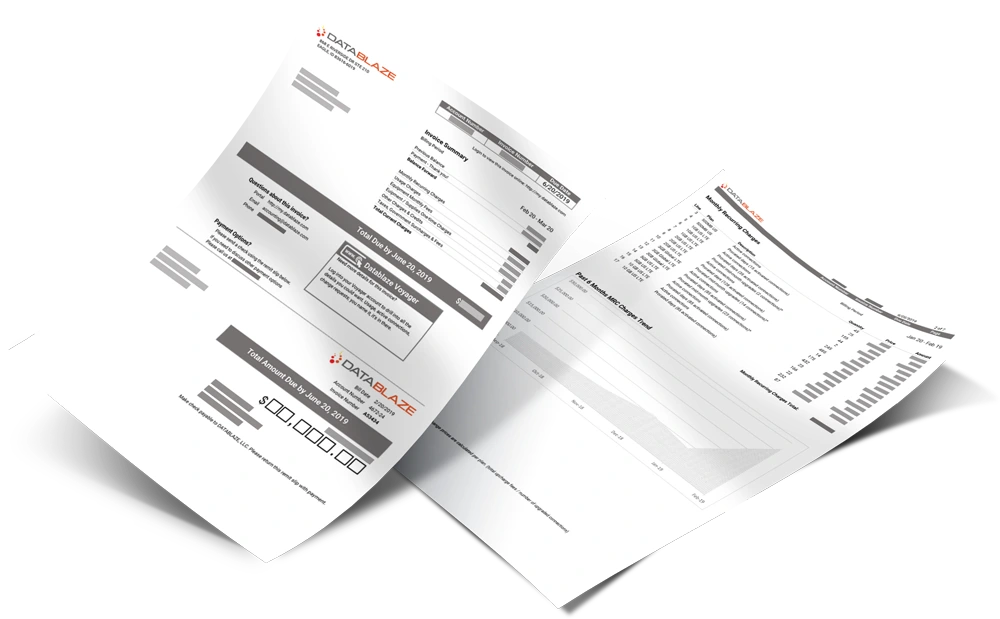

Multi-Carrier
Global Connectivity
A single SIM solution with eSIM and multi-IMSI technology allowing mobile IoT devices to activate globally and access IoT cellular connectivity services via a local carrier.
Streamlined Features for Simplified Cellular IoT Connectivity
Autonomous Switching: Over-the-air (OTA) reprogrammable IMSIs. Enabling autonomous changes between networks.
Any GSM Technology: Choose the connectivity that best suits your application whether its 4G/LTE, 5G, NB-IoT or LTE-M.
Global Coverage: Cellular connectivity through a local carrier, mitigating permanent roaming restrictions.
Unify Devices and Connectivity: Access Datablaze’s cloud-based software, VOYAGER, providing one unified platform for device and SIM management.
Real-time Alerts: Get notified of subscribers that are approaching overage.
Improve Deployment Time: Reduce time to select data plans and activate SIMs with an all-in-one solution.

Worldwide Reach: Scalable Connectivity for Every IoT Application
Connect to over 670 carriers in more than 220 countries.
Select the connectivity option that aligns most effectively with your application, whether it be 4G/LTE, 5G, NB-IoT, or LTE-M. Adapt seamlessly to the optimal network according to your device’s geographical location.
Streamlined Deployment Simplifying SIM Activation and Data Plan Selection
Streamline deployment processes by minimizing the time required for selecting data plans and activating SIM cards through the utilization of a multi-IMSI SIM solution. This comprehensive approach accelerates deployment timelines, allowing your team to swiftly implement IoT connectivity without the delays typically associated with single-carrier SIM provisioning.
Remote SIM Provisioning for One SKU Integrations
With eUICC (embedded Universal Integrated Circuit Card) enabled SIMs, IMSI profiles are remotely managed, facilitating dynamic provisioning and over-the-air updates. This eliminates the need of maintaining multiple physical SIMs and avoids the requirement for onsite visits to swap SIM cards. These innovations in SIM technology deliver unmatched flexibility, scalability, and security, enhancing the efficiency of IoT deployments.
Security
Data stays within the originating country, and connections can be terminated as needed to adhere to privacy regulations like GDPR.
Also, add services like private APN and static IPs.
With Multi-Carrier Scalability Comes One Platform to Manage an Entire IoT Deployment

Scalable All-in-One Award Winning Platform
Effortlessly oversee your DB1 multi-carrier SIMs alongside single-carrier SIMs with existing subscriber agreements, all within a unified platform. VOYAGER seamlessly integrates all cellular connectivity subscriptions, streamlining the management of data plans, usage, and billing.
Consolidate and Simplify Wireless IoT Billing
VOYAGER IoT Management relieves the stress of calculating confusing data service invoices. Even when combining DB1 SIMs with other carrier accounts and data plans, consolidate your billing into one, easy to read invoice.
- Invoicing that simply and accurately explains monthly charges
- Direct Excel spreadsheet exports for easy custom calculations
- Breakdowns by customizable labels and groups
- Detailed charges with no guesswork.

Multi-Tenant Management for Increased Revenue Opportunities
Multi-tenant features provide businesses with the capability to conveniently manage multiple separate entities from one platform. Each user, or tenant, can access only the devices and subscriptions that they are authorized to. Furthermore, wireless costs can be passed on to clients for easy billing.
Questions about Multi-IMSI SIM Cards?
This article gives a detailed explanation about multi-IMSI SIM cards and how they work.
Multi-Carrier SIM FAQs
A multi-carrier SIM card is a special type of SIM card that allows you to switch between different mobile network carriers without changing the physical SIM card. It offers flexibility and convenience by enabling access to multiple networks on a single SIM card.
A multi-carrier SIM card contains profiles for multiple mobile network operators. These profiles typically refer to an IMSI. When you insert the SIM card into your device, it detects the available networks and allows you to select the desired one. You can easily switch between networks through your device’s settings without needing to swap SIM cards.
IMSI stands for International Mobile Subscriber Identity. It is a unique identification number assigned to each mobile subscriber globally. The IMSI is stored on the SIM (Subscriber Identity Module) card inserted into your mobile device. It comprises three parts: the Mobile Country Code (MCC), Mobile Network Code (MNC), and Mobile Subscriber Identification Number (MSIN). Together, these components uniquely identify a mobile subscriber and facilitate their authentication and access to mobile networks. The IMSI plays a crucial role in enabling seamless communication between your device and the mobile network infrastructure.
A multi-IMSI (International Mobile Subscriber Identity) SIM card is a type of SIM card that can store multiple IMSI numbers. The IMSI is a unique identifier associated with a mobile subscriber in a GSM or UMTS network. By having multiple IMSI numbers stored on a single SIM card, a user can switch between different mobile network operators or different subscriptions within the same operator without changing the physical SIM card. This can be useful for users who travel frequently or who want to take advantage of different pricing plans or network coverage options offered by different operators.
Most unlocked GSM or LTE-compatible devices are compatible with multi-carrier SIM cards. However, it’s always a good idea to check with your device manufacturer or carrier to ensure compatibility before purchasing a multi-carrier SIM card.
No, you do not need to download any special software or apps. Selection of the desired carriers on the multi-carrier SIM card, is either done automatically based on the SIM provider’s settings, or manually selected by the SIM provider or user in a cloud-based administration portal.
With traditional SIM cards, switching carriers requires getting a new SIM and manually inserting it into your device. With SIMs like the Datablaze DB1 eUICC technology allows SIMs to store multiple profiles and enables remote SIM provisioning, so you can change carriers Over-the-Air.